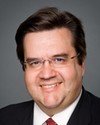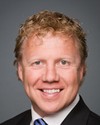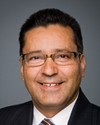Thank you, Mr. Chairman.
Mr. Chairman, Members of the Committee, good afternoon.
I am pleased to be here today to address the Commission’s decision.
There's been a significant amount of misinformation circulating about this shipment. I hope you will find the following technical presentation useful.
I always appreciate the opportunity to provide clarity on a nuclear file, particularly given that our mandate is to actually disseminate some objective information.
We represent the Canadian Nuclear Safety Commission.
We were established in May 2000 under the Nuclear Safety and Control Act, which replaced the AECB that was established in 1946.
Some of you may not realize we are now celebrating our 65th anniversary. We're not planning to retire any time soon. We are very proud of our safety culture and our safety record, which I would like to argue is second to none.
We are a quasi-judicial administrative tribunal. All our commissioners are independent.
The Commission’s hearings are public and broadcast over the Web. Our decisions are transparent and science based.
Let me start by trying to be very clear. Canada has a clear radioactive waste policy and all applicants to the CNSC must comply with that particular policy. It is based on the environmental principles of reduce, reuse, and recycle. There is a very well-defined international framework that explains what those words mean. There are domestic regulations and policies, and we've listed all the policies and documents that can shed light on this idea that there is no policy.
It is important to note that Canada has a clear policy on nuclear waste.
How is the transport of nuclear substances regulated?
First of all, all nuclear substances are governed by the International Atomic Energy Agency, which is governed by the international maritime dangerous goods code. There is a CNSC regulation for the packaging and transport of nuclear substances. There is a Transport Canada regulation for the transportation of dangerous goods. In the steam-generated case, you need a Swedish and a U.S. authority.
By the time anybody can comply with all those regulations, this would be the safest shipping of any hazardous material that I can think of.
There are many dangerous goods that are regularly transported in the St. Lawrence Seaway. There is a list, and if you look at the last item, it includes yellowcake uranium. They're shipped in and out every day of the year.
By the way, none of that shipping requires a municipality authorization to go through. It is routine business.
No precedent is being set. Millions of shipments of nuclear substances in Canada are transported every year. In Montreal alone, each year there are over 9,000 shipments that pass through the Montreal Trudeau Airport, over 1,000 shipments through the Port of Montreal, and over 50,000 medical isotopes. It is a routine activity, with no safety issues.
Why are there no safety issues?
We do not have problems because we use pre-approved packages.
We use internationally pre-approved transport packages. They are internationally approved, and therefore, when you package radioactive material in those packages, there is no need for any further approval. It gets shipped like any other commodity.
Let's turn to steam generators on slide 9. What's different about steam generators? It's their size. They do not fit in a pre-approved package, and therefore they require what is known as special arrangements. It does not mean they get a kind of “wink, wink, we'll approve it”. It means there is no approved package; therefore, we have to look at the safety case on a case-by-case basis.
I just point out to you that there are four grams of radioactive material. If we could put all of this in a pre-approved package, we wouldn't be appearing in front of you. This would have gone routinely through the system.
So what's inside those steam generators? If you look at slide 10, you will see that there are 65 kilometres of inner tubes. In those tubes, that's where water gets circulated and turned into steam. Over the 25 years of the life of the steam generator, there is a minute amount of radioactive deposit on the inside of those tubes.
It's important to understand that the outer shell is five centimetres of clean steel. I was trying to give you a scale. Do you see the little black box on the right? The width of the shell is five centimetres. This is not an aluminum cooking pot. This is a significant clean steel that provides safe package for the amount of nuclear material inside it. That explains why there's such low radioactivity on the outside.
If you look at slide 11, we actually compare some of the radioactive detection, the dose rate, beside the steam generator, and you can see its equivalent is less than the medical isotope boxes in which we ship all medical isotopes across the world.
If you look at slide 12, you will see that it compares the radioactive dose with background radioactivity and medical procedures, and you can see this is a really small amount of radioactive material.
On slide 13 there is one more kind of analogy, that the total amount of radioactivity inside a steam generator is less than the amount of radioactivity in a pacemaker.
Okay, so let's turn now to le processus de la commission. We held public hearings on September 28 and 29, 2010; 78 interventions appeared in front of us. It was two days of hearings, 22 hours of public hearings.
Several Quebec stakeholders had the opportunity to present to the Commission.
We've been accused of not allowing Quebeckers to participate.
We have included the list of all the witnesses that appeared before the Commission. It was a comprehensive public consultation process.
We listened in the first round of hearings to some of the issues. We took an additional amount of time to study some of the issues and allowed everybody additional time to provide further information. We carefully considered all the presentations given by all interveners, our staff, and everybody else in the analysis.
The hearing was widely disseminated both in Ontario and Quebec. In addition to this, CNSC staff made numerous presentations to city councils, mayors, and aboriginal councils. Anybody who wanted to know about this file and asked got a visit from our staff, who made a technical presentation about what was involved.
The next slide tries to explain the kind of analysis and science undertaken. CNSC staff totally evaluated the following safety areas, as listed here. It's important to understand that in doing this evaluation, they took into account all the presentations that were put in front of us.
On packaging and transport, all careful measures were taken into this proposal. The transport vehicle will not go faster than 30 kilometres per hour. The ship is a specialized nuclear qualified ship. It's only loaded at 25% of its capacity, and the crew is very well trained. The conclusion is that the packaging and transport comply with national and international regulations.
We've been accused of not doing environmental assessments. I have to tell you that we had legal opinions that there was no trigger under the CEAA for an environmental assessment. I know this is being contested now in front of a judicial review. But I have to tell you that we do such environmental assessments routinely on practically every project we do, from uranium mines to nuclear approval. It's the same CNSC staff who are doing the environmental assessments.
The staff evaluated some multiple worst-case scenarios, and the bottom line is that the risk for the environment....
In the worst case scenario, the danger to the environment and human health would be negligible.
The finding was the same for protection measures. We concluded the following:
The dose to the workers and members of the public would be less than 0.1% of the limit for members of the public, which is negligible.
We reviewed Bruce Power's emergency response plan and the International Maritime Organization regulations, and the commission concluded that the emergency measures are adequate.
You can imagine that there are a lot of organizations involved in sharing security, including Transport Canada, the Marine Security Operation Centre, the RCMP, the Coast Guard, the Ontario Provincial Police, and la Sûreté du Quebec.
We concluded that the safety measures were adequate.
In conclusion, the commission is satisfied that the transport can be completed safely and that the risk to persons and the environment is negligible. The shipment meets all Canadian and international regulations and requirements, and Bruce Power is qualified to carry out the plan.
Overall the plan is good for the environment. It's recycling clean steel. It's good waste management practice--it reduces the volume of waste by 90%--and it is safe.
I'd just like to remind everybody about our battle cry, if you like: The commission will never compromise safety.
We will never compromise safety. Thank you very much.











